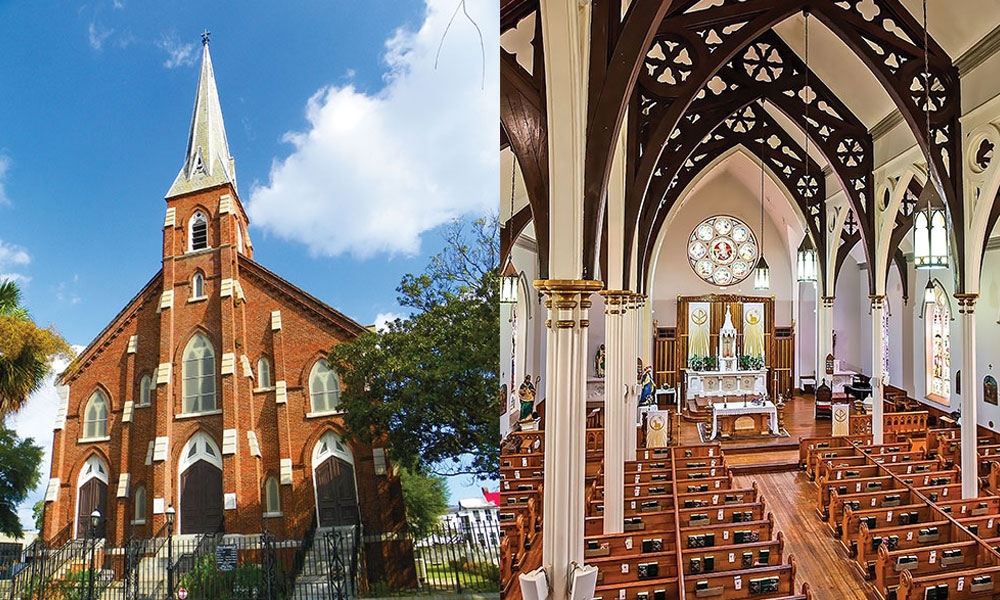
A place to call home: Renovating St. Patrick
Parishioners of St. Patrick Church will soon helm a new African American Heritage Center and enjoy Mass in an improved house of worship.
Parishioners of St. Patrick Church will soon helm a new African American Heritage Center and enjoy Mass in an improved house of worship.
Father JohnBosco Ikemeh, pastor, said that St. Patrick is up for the challenge.
“I would like to see the Heritage Center be a place where our children will come to learn music and dance. A place where the young and old will come to celebrate life,” he said.
The work ahead of them will not be easy and renovations are long overdue.
Soon & very soon
Father Ikemeh has been with St. Patrick for a little over a year, and he said he sees so much potential, however, it will require repairs. First on the list is leveling the unsafe platform in front of the altar, he said.
“Right now, it is difficult for the elderly or anyone who is physically challenged to come to the altar for communion. We are going to remove the platform in front of the altar and bring it to the level of the church floor so that people [don’t have to step] up or down,” he explained.
The parish has an upper level sanctuary, and a lower level that was used as a parish hall until the 2015 renovations. Father Ikemeh plans to hold Masses there. Since the sanctuary will be shut down, the parish wants to take the opportunity to refurbish the rest of the wooden floor and paint the sanctuary.
Repairs will be funded in part by a diocesan grant, with the remainder requiring fundraising. Father Ikemeh said that they will consult with the Office of Stewardship & Mission Advancement and the Finance Council. The work can begin once all the plans are approved and permission is granted.
200 years in the making
The church, located now on St. Phillip Street in downtown Charleston, dates to 1838 when its cornerstone was laid on St. Patrick’s Day.
Construction on a new church began in 1886, but was halted by an earthquake that year. Building resumed thanks to national donations, and the new St. Patrick was consecrated in May 1887.
By 1967, the parish absorbed neighboring, predominantly African American parishes Immaculate Conception and St. Peter, and began serving Black Catholics on the peninsula. In 2014, another predominately African American parish, Our Lady of Mercy, also closed and was merged with St. Patrick.
In 2015, parishioners renovated the old St. Patrick School building, located across the street from the parish, into a fully updated hall with church offices.
Community solutions
Father Ikemeh said they want to refurbish the existing elevator and bring that up to date.
“Our old service elevator is not able to take more than two people at a time and a few people have been stuck … It is a safety hazard now. Our plan is to install a new elevator that can also accommodate a casket.”
He also said that some of their elderly and physically challenged choir members cannot currently access the choir loft. “We need to find a solution to this as a community.”
He mentioned that the brick wall of the church needs repairs and that the slabs on the steeple are falling off. Father Ikemeh said these and a few more things need to be done sooner rather than later.
A living heritage
As for the African American Heritage Center, the priest said he has great plans for it.
“The Heritage Center will be in the lower church; I will be asking for input as we plan to create a center that is the first of its kind.”
St. Patrick is known for its choir and is the only parish in the diocese to celebrate Masses that feature all jazz music.
“Spirituals, singing, jazz music and dance are all part of African American heritage. Most of the people we have in the choir today are older. If we don't do anything about it, we will lose this charism that is uniquely St. Patrick, our heritage,” Father Ikemeh said.
He added that the center will not be a museum with collections and artifacts, “Rather, it is going to be a living center where African American cultural heritage is advanced and celebrated. It will be a center where our youths will come to learn and perform authentic Black spirituals and dance which are part of African American heritage. It is our [hope] that bringing the youths to the center will bring them to the church.”
He said they would like to finish the entire project in three years.
“My primary vision for this parish is to grow a vibrant, welcoming and loving parish that we will be proud to call ‘domus,’ or our home,” the pastor concluded.
Theresa Stratford is a freelance writer for The Miscellany. She lives in Charleston with her husband and three children and attends the Cathedral of St. John the Baptist. Email her at tmmart89@gmail.com.
